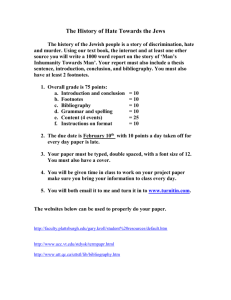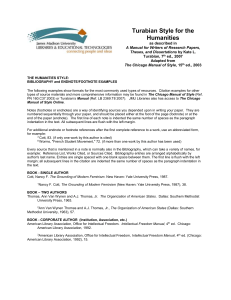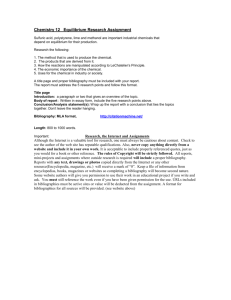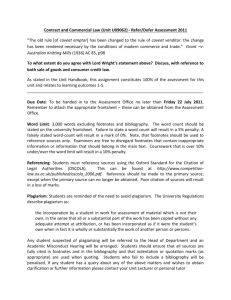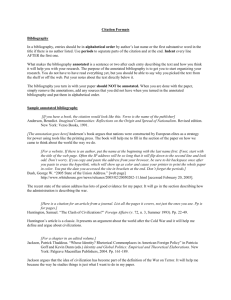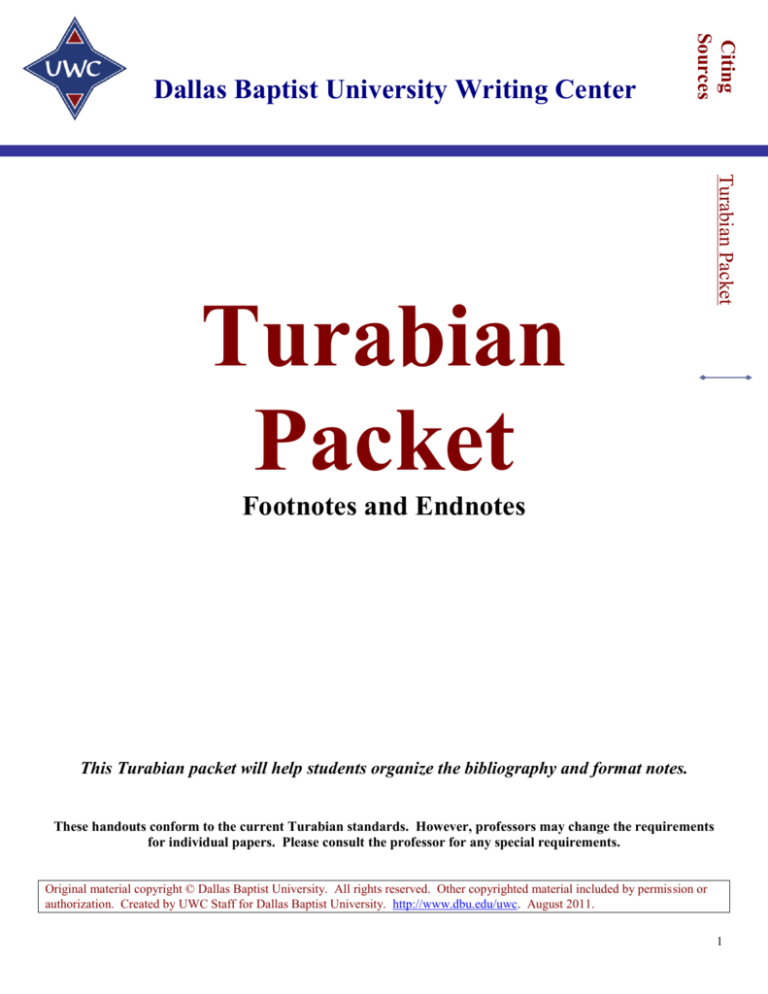
Citing
Sources
Dallas Baptist University Writing Center
Turabian Packet
Turabian
Packet
Footnotes and Endnotes
This Turabian packet will help students organize the bibliography and format notes.
These handouts conform to the current Turabian standards. However, professors may change the requirements
for individual papers. Please consult the professor for any special requirements.
Original material copyright © Dallas Baptist University. All rights reserved. Other copyrighted material included by permission or
authorization. Created by UWC Staff for Dallas Baptist University. http://www.dbu.edu/uwc. August 2011.
1
Sample Pages
Title page for a class paper (Pg. 378)
Title page for a dissertation (Pg. 379)
DALLAS BAPTIST UNIVERSITY
THE FIRST CHAPTER OF GENESIS
ESSAY SUBMITTED TO
THE FIRST CHAPTER OF GENESIS
DR. MILLER
IN PARTIAL FULFILLMENT OF THE
REQUIREMENTS FOR THE COURSE
OLD TESTAMENT SURVEY
RELI1301
-orIma Student
Old Testament Survey 1301
January 9, 2010
DEPARTMENT OF RELIGION
BY
IMA STUDENT
DALLAS, TEXAS
9 JANUARY 2010
Sample first page
Sample second page
3
Lorem ipsum dolor sit amet, consectetuer adipiscing elit. Ligula eget
Introduction
dolor. Aenean massa. Cum sociis natoque penatibus et magnis dis
Lorem ipsum dolor sit amet, consectetuer adipiscing elit.
parturient montes, nascetur ridiculus mus Lorem ipsum dolor sit.
Aenean commodo ligula eget dolor. Aenean massa. Cum sociis
natoque penatibus et magnis dis parturient montes, nascetur
Subheading
Donec quam felis, ultricies nec, pellentesque eu, pretium quis,
ridiculus mus. Donec quam felis, ultricies nec, pellentesque eu,
sem. Nulla consequat massa quis enim. Donec pede justo, fringilla
pretium quis, sem. Nulla consequat massa quis enim. Donec pede
vel, aliquet nec, vulputate eget, arcu. In enim justo, rhoncus ut,
justo, fringilla vel, aliquet nec, vulputate eget, arcu. In enim justo,
imperdiet a Aenean leo ligula, porttitor eu, consequat vitae, eleifend
rhoncus ut, imperdiet a, venenatis vitae, justo. Nullam dictum felis
ac, enim. Aliquam lorem ante, dapibus Aenean imperdiet:
eu pede mollis pretium. Integer tincidunt. Cras dapibus. Vivamus
elementum semper nisi. Aenean vulputate eleifend tellus. Aenean
leo ligula, porttitor eu, consequat vitae, eleifend ac, enim. Aliquam
Maecenas. Donec vitae sapien ut libero venenatis faucibus.
Lorem ipsum dolor sit amet, ligula eget dolor. Aenean massa.
Nulla consequat massa quis enim. Donec pede justo, fringilla
ve. Lorem ipsum dolor sit amet, Lorem ipsum dolor sit amet,
Lorem ipsum dolor sit amet, Lorem ipsum dolor sit amet.1
lorem ante, dapibus in, viverra quis, feugiat a, tellus. ultricies nisi
Etiam ultricies nisi vel augue. Donec vitae sapien ut libero venenatis
rhoncus. Maecenas tempus, augue velit, Lorem ipsum dolor sit amet,
faucibus. Lorem ipsum dolor sit amet amet feugiat.
consectetuer adipiscing elit. Aenean commodo ligula eget dolor.
Aenean massa. Lorem ipsum dolor sit amet,
1
Lorem Ipsum, Dolor Sit Amet (Consectetuer: Adipsicing Elit,
2008), 123.
2
2
Turabian Basics
Title Page (Pg. 377-379, 386-387 in the Turabian Manual)
On the title page for a class paper, center the title in all caps. About seven spaces down, type the student’s
name, the course name and number, and the date of submission. (See example above.)
On the title page for a dissertation, type the following information centered and in all caps: Dallas Baptist
University, Title, Essay submitted to (professor’s name) in partial fulfillment of the requirements for the course
(class and course number), class department (ex. Department of Philosophy), by (student’s name), location
(Dallas, TX), and the date. (See example on page 2.) This was the standard title page in the 6th edition of
Turabian, and many professors still prefer this style. Be sure to consult with your professor for specific
guidelines.
Margins (Pg. 374)
Margins are to be 1” on all sides of the page. (In Microsoft Word, under “Page Layout,” click on “Margins”
set the measurements to “Normal.” This should set all margins at 1”.)
Pagination (Pg. 375-376)
The page header should be .75” from the top and 1” from the right-hand edge of the paper.
Microsoft Word does not have a simple way to format Turabian-style pagination, so it takes a little extra
attention. Detailed instructions are available on the last page of this packet.
There should not be a number on your Title Page—but it does count as page #1. On the first page of text and on
the bibliography page, center the number at the foot of the page. On all other pages, the number should be in
the upper right corner. If a Table of Contents or any pretext are included, mark the pages with lowercased
Roman numerals (ex. i, ii, iii, iv). (If turning in a hard copy only, it may be easier to print the pages with one
style of pagination, change the pagination, then print the rest out separately.)
Spacing (Pg. 375)
Double-space the body of the paper. Single-space footnotes, block quotes, and each entry on the bibliography
page; however, a blank line is needed between each entry in the bibliography. (On campus computers, the
button for line spacing is found under the “Home” menu, in the “Paragraph” section. Highlight and click
“2.0” to double-space the paper.)
Indents (Pg. 147, 350, 375)
Tab once before all paragraphs and footnote entries. For quotes longer than five lines, single-space and indent
each line as a block quote with no quotation marks. (See page 4 and 6 of sample paper.)
Subheadings (Pg. 397-398)
Turabian utilizes subheadings to transition and indicate different sections of the paper. These are generally
centered and bold, in 12 point font. Some professors prefer these headings to be in all caps with no bolding.
However, according to the manual, it is also acceptable to create a unique typography as long as it is used with
consistency (pg. 398). Second and third-level subheads may also be used if necessary; however, in a typical
class paper, one level of subheads is usually sufficient.
The first page of text and the bibliography page should include a 2” gap before the first heading. Other pages
will maintain 1” margins on all sides. However, if the natural length and format of the paragraphs leaves a
subheading dangling on the end of a page, it is acceptable to insert an extra line to push that title to the next
page and the accompanying information. See the sample paper for examples of all of this information.
3
Names and Titles (Pg. 75, 167, 308-309, 316-317)
Within the paper, the first reference to a researcher or author should include the entire name. In subsequent
references, only the last name needs to be included.
Complete works should be italicized, and parts of these works—such as articles, chapters, etc.—should be typed
in “quotation marks.”
Numbers (Pg. 319-330)
The general rule is to spell out all numbers up to one hundred and any whole numbers followed by hundred,
thousand, hundred thousand, million, and so on. Numerals are used for all other numbers.
Formatting Citations
Styles for Citing Sources in Your Paper (Pg. 136-137, 151-159)
In Turabian style, there are two citation options. The first uses footnotes or endnotes, and the other uses
parenthetical references. The instructor will usually indicate which type of documentation to use. If the
professor does not have a preference, the student may decide which method to use, and then use only that
method throughout the paper. Since the majority of professors prefer footnotes or endnotes, this packet
addresses this style only for the sake of simplicity. If instructed to use parenthetical citations or if the student
prefers them, the Writing Center has a separate handout that addresses this alternative.
Why Cite?
If someone else’s ideas or words are used to help create ideas and reach conclusions while writing, credit must
be given to the author of the source; otherwise, the student is plagiarizing. Footnotes and endnotes are used to
show where credit is due.
Endnotes (Pg. 151-153)
Turabian defines endnotes as footnotes that are included on a separate page (before the bibliography page)
rather than at the bottom of each page. Entitle the page “Notes.” The format of endnotes follows the same
pattern as footnotes, so simply refer to the entries labeled “Footnote” when creating notes. Some professors
want only footnotes for Turabian papers, while others allow any of the citation formats. If the student is unsure
of which format to use, the professor should be consulted.
Basic Format of Footnotes (Pg. 152)
Footnotes should be inserted on the bottom of the page. There should be a line separating the text from the notes
(Microsoft Word should automatically create this for you if you use the insert footnote function.) Footnotes
should be typed in either 10 or 12 point font (Pg. 374).
In Microsoft Word, click on the “References” tab, then click on the “Insert Footnote” button. Word will
automatically insert the reference number and bring the cursor to the bottom of the page.
The first time a source is used, all the publication information should be listed within the footnote.
Each new source used within the paper will have a lengthy footnote that nearly parallels a bibliography
entry.
For all subsequent references to this source, omit the publication information and just include the
author’s last name, a comma, and the page number: 3Jones, 23.
If two or more works from the same author are used in the paper, also include a shortened version of
the title: 3Jones, Truth, 23 (Pg. 154-155).
4
If two consecutive references are from the same source, use the term “Ibid.” This stands for “in the
same place.” (Pg. 155-157). See the following examples:
1
Firstname Lastname, The Writing Center Guide to Turabian Format: How to Write and Cite Properly
(Dallas: Publishing Company, 2004), 73.
2
Ibid., 17.
3
Somebody Wroteabook, Another Book Title: Creativity in Naming (New York: Spaghetti Sauce
Publishers, 1997), 27.
4
Lastname, 12.
5
Ibid.
NOTE: When using footnotes or endnotes, most titles are capitalized using headline style. Capitalize the first word and all other words
except unimportant prepositions, articles, and conjunctions. For most foreign language titles, sentence-style capitalization should be
used for titles of works. Capitalize the first word and all proper nouns. (Pg. 313-317)
Bibliography (Pg. 147-150, 221, 375, 401, 404)
If footnotes are used, there will be a page titled “Bibliography” at the end of the paper. This will include an
alphabetized list of all the sources consulted for the paper. Single-space these entries, but leave a blank line
between each entry. The first line of each entry should be aligned all the way to the left; if an entry is two lines
or longer, each subsequent line should be indented. See the following example.
Lastname, Firstname. The Writing Center Guide to Turabian Format: How to Write and Cite Properly.
Dallas: Publishing Company, 2004.
(To format hanging indents in Microsoft Word, right click on the text, and select “Paragraph.” Under the
“Indentation” section, select “Special: Hanging.”)
Center the page number on the bibliography page at least .75” from the bottom of the page Any subsequent
bibliography pages will have the page number in the upper right corner.
Differences Between the Format of Footnotes and Bibliography Entries
Be sure to note these few differences as you format your citations:
Footnotes format the author’s name first name last name, whereas bibliography entries format the
author’s name last name, first name.
With footnotes, the first line is indented and any subsequent lines are flush to the left, whereas
bibliography entries have a hanging indent (the first line is flush to the left, and subsequent lines are
indented.)
Footnotes use commas and parentheses to separate elements in the entry, whereas bibliography entries
use periods.
Footnotes include specific page numbers where the information was found, whereas bibliography
entries only include page numbers if they indicate the pages of a complete article or chapter consulted.
Footnotes are numbered and ordered according to where the information is introduced in the text,
whereas bibliography entries are always alphabetized and not numbered.
Printed Sources
The following are examples of citations for research from printed sources (books, magazines, newspapers, and
other non-electronic sources.) If online versions of printed sources have been consulted, refer to the “Internet
Sources” section.
5
Each entry should include any of the following information that is available about the source:
Author’s name
Book title
Article or chapter title
Page numbers for articles/chapters
Journal or magazine title
Volume, issue, edition, etc.
Place of publication
Publishing company
Copyright date
Editor, translator, etc.
Book with One Author (Pg. 143)
Footnote
1
James Daniels, Postmodernism and Scripture: Cultural Analysis and Repercussions (Ennis, TX: Dallas
Baptist University Press, 2006), 78.
Bibliography
Daniels, James. Postmodernism and Scripture: Cultural Analysis and Repercussions. Ennis, TX: Dallas Baptist
University Press, 2006.
(It is not necessary to include the state or country for well-known locations like New York, Oxford, or Chicago.
For less well-known cities, include the state.)
Book with Two Authors (Pg. 143, 163)
Footnote
1
Roman Jakobson and Linda R. Waugh, The Sound Shape of Language (Bloomington, IN: Indiana
University Press, 1979), 78.
Bibliography
Jakobson, Roman, and Linda R. Waugh. The Sound Shape of Language. Bloomington, IN: Indiana
University Press, 1979.
Book with Three Authors (Pg. 143-144, 163)
Footnote
1
Jane Lee, Bryce Jones, and Henry Lope, The Enchanted Book (New York: Harcourt, Brace and World,
1983), 98.
Bibliography
Lee, Jane, Bryce Jones, and Henry Lope. The Enchanted Book. New York: Harcourt, Brace and
World, 1983.
Book with More Than Four Authors (Pg. 144, 164)
Footnote
1
Sander Gilman et al., Hysteria Beyond Freud (Berkeley: University of California Press, 1993), 110.
6
Bibliography
Gilman, Sander, First Last, First Last, First Last, and First Last. Hysteria Beyond Freud. Berkeley: University
of California Press, 1993.
Book with an Editor (Pg. 144,146-147)
Footnote
1
Thomas Briggs, Living with Plants, ed. Marlene Day (London: Methuen, 1998), 79.
Bibliography
Briggs, Thomas. Living with Plants. Edited by Marlene Day. London: Meuthen, 1998.
Two or More Books by the Same Author (Pg. 148-149)
Footnote
1
Will Durant and Ariel Durant, The Age of Voltaire (New York: Simon, 1965), 47.
2
Will Durant and Ariel Durant, A Dual Autobiography (New York: Simon, 1977), 23.
Bibliography
Durant, Will, and Ariel Durant. A Dual Autobiography. New York: Simon, 1977.
________. The Age of Voltaire. New York: Simon, 1965.
(For the underlined space, type the underscore 8 times before the period.)
A Work in a Collected Work (Pg. 177-179) – Use this for a Biblical commentary
Footnote
1
Laura Hooten, “The Chicago Statement on Biblical Inerrancy and the Biblical Worldview,” in The
Proceedings of the Conference on the Christian Worldview, ed. David Eugene (Ennis, TX: Dallas Baptist
University Press, 2008), 117.
Bibliography
Hooten, Laura. “The Chicago Statement on Biblical Inerrancy and the Biblical Worldview.” In The Proceedings
of the Conference on the Christian Worldview, edited by David Eugene, 114-152. Ennis, TX: Dallas
Baptist University Press, 2009.
An Encyclopedia Article without an Author (Pg. 191)
Footnote
1
The Encyclopedia Americana, 1993 ed., s.v. “Mandarin.”
(Note: s.v. represents “sub verbo” or “under the word”.)
Bibliography
No bibliography entry is needed for well-known reference books.
An Encyclopedia Article with an Author (Pg. 191)
Footnote
1
Jitendra M. Mohanty, “Indian Philosophy,” in The New Encyclopedia Britannica: Macropedia, 15th ed.
7
Bibliography
No bibliography entry is needed for well-known reference books.
An Anonymous Book (Pg. 165-166)
Footnote
1
A Guide to Our Federal Lands (Washington: National Geographic Society, 1984), 26.
Bibliography
A Guide to Our Federal Lands. Washington: National Geographic Society, 1984.
Interviews and Personal Communications (Pg. 195)
Footnote
1
Arthur Jones, interview by Ima Student, January 21, 2008.
Bibliography
No bibliography entry is needed for interviews.
Editor or Compiler as “Author” (Pg. 143, 164)
Footnote
1
Richard McKeon, ed., The Basic Works of Aristotle (New York: Random House, 1941), 33.
Bibliography
McKeon, Richard, ed. The Basic Works of Aristotle. New York: Random House,
1941.
A Multivolume Work (Pg. 171-2)
Footnote
1
Stanley Sadie, ed., The New Grove Dictionary of Music and Musicians (London: MacMillan, 1980), 12:
129.
Bibliography
Sadie, Stanley, ed. The New Grove Dictionary of Music and Musicians. Vol. 12. London: Macmillan, 1980.
Article from a Scholarly Journal (Pg. 145, 181-185)
Footnote
1
Max Deluch, “Mind from Matter,” American Scholar 47, no. 7 (Spring 1978): 343.
Bibliography
Deluch, Max. “Mind from Matter.” American Scholar 47, no. 7 (Spring 1978): 339-53.
Magazine Article (Pg. 185-186)
Footnote
1
John Smith, “Preparing for 2000,” Technology Today, March 10, 1994, 88.
Bibliography
Smith, John. “Preparing for 2000.” Technology Today, 10 March 1994.
8
Internet Sources
For the most part, the same important information for a printed source must be reported for electronically
accessed sources. However, there are a few extra things that are very important to include. For example,
because the Internet is constantly changing, it is essential to record the date the information was accessed.
When citing a document from the World Wide Web, include as much of the following information as possible.
Some sources will not provide all of the information, in which case it is acceptable to leave that detail out. If the
material being cited does not have an author, for example, simply begin with the title of the document.
Author’s name
Title of document in quotation marks for notes style
Title of website from which the document was retrieved, in italics
Any other pertinent data about the source or contributors (journal title, volume, issue, editor, etc.)
URL
Date of access
General Internet Site (Pg. 198)
Footnote
1
Firstname Lastname, “Title of Article or Document,” Title of Complete Work or Website,
www.url.com (accessed month day, year).
Bibliography
Lastname, Firstname. “Title of Article or Document.” Title of Complete Work or Website. www.url.com
(accessed month day, year).
Electronic Journal Article (Pg. 145)
Footnote
1
Ivana Novak, “Keeping Up with Bicarbonate,” The Journal of Physiology 528, no. 2 (October 20,
2000), under "Medications," http://www.jphysiol.org/cgi/content/full/528/2/235 (accessed October 24, 2000).
Bibliography
Novak, Ivana. “Keeping Up with Bicarbonate.” The Journal of Physiology 528, no. 2. (October 20, 2000).
http://www.jphysiol.org/cgi/content/full/528/2/235 (accessed October 24, 2000).
Article Obtained Through Electronic Database in DBU Library (Pg. 185, 193-194)
Footnote
1
Francis Oakely, “The Great Papal Schism,” Christian History 9, no. 4 (June 13, 1990): 25.
http://search.ebscohost.com/login.aspx?direct=true&db=a9h&AN=9604244285&site=ehost-live (accessed
April 8, 2007).
Bibliography
Oakley, Francis. "The Great Papal Schism." Christian History 9, no. 4 (June 13, 1990): 23-27.
http://search.ebscohost.com/login.aspx?direct=true&db=a9h&AN=9604244285&site=ehost-live
(accessed April 8, 2007).
9
Using the Bible as a Source
When using a biblical commentary, follow the example for “A Work in a Collected Work.”
When referring to whole chapters or books (Pg. 190, 340-344)
Spell the complete name. Books and versions of the Bible are not underlined, italicized, or “in quotations.”
Ex: The New Testament was written after Christ resurrected from the dead.
Ex: This passage is taken from the New American Standard Bible.
Ex: The book of Hebrews has an anonymous author.
Ex: Proverbs 31 may be one of the most beautiful chapters in the Bible.
When citing by verse
Use abbreviations both in text and in notes.
List the chapter and verse, separated by a colon (pg. 340). Always be consistent. Identify which version
is being cited. It is good to list the version with the first citation and mention in the footnote that all
Bible sources will be the same version unless otherwise stated; after that the version does not need to be
listed in the text.
If the reference is given in the sentence, no footnote is necessary unless the version needs to be
specified.
Ex: Gen. 1:1 KJV
Ex: 1Rev. 1.1 NASB. All subsequent Scripture quotations are taken from the New American Standard
Version unless otherwise stated.
Ex. Genesis 1:1 says, “In the beginning God created the heavens and the earth.”
Punctuation (Pg. 340)
Commas are used to indicate that only the listed numbers are being cited. A hyphen is used to indicate
inclusive numbers.
Ex: Col. 3:16, 23
Col. 3:16-23
(only verses 16 and 23 are being cited)
(every verse from 16 to 23 is being cited)
Bibliography List and Notes (Pg. 190-191)
Biblical citations omit all facts of publication, including place (city), publishing agency, and date.
Footnote
6
2 Cor. 5:13 KJV (King James Version).
Bibliography
The Holy Bible, King James Version.
(Usually the Bible is not included on the bibliography page, but it is acceptable to add it. If it is included, use
the information above.)
10
Citing a Study Bible (Pg. 143, 231)
If citing the notes from a study Bible, one should cite it like an ordinary book with an editor as author.
Footnote
1
W. A. Criswell, ed., The Believer’s Study Bible, New King James Version (Nashville: Thomas Nelson,
1991), 35.
Bibliography
Criswell, W. A., ed. The Believer’s Study Bible, New King James Version.
Nashville: Thomas Nelson, 1991.
Abbreviations (Pg. 341-343)
Old Testament
Gen.
Exod.
Lev.
Num.
Deut.
Josh.
Judg.
Ruth
1 Sam.
2 Sam.
Genesis
Exodus
Leviticus
Numbers
Deuteronomy
Joshua
Judges
Ruth
1 Samuel
2 Samuel
1 Kings
2 Kings
1 Chron.
2 Chron.
Ezra
Neh.
Esther
Job
Ps.
Prov.
1 Kings
2 Kings
1 Chronicles
2 Chronicles
Ezra
Nehemiah
Esther
Job
Psalms
Proverbs
Eccles.
Song of Sol.
Isa.
Jer.
Lam.
Ezek.
Dan.
Hosea
Joel
Amos
Ecclesiastes
Song of Solomon
Isaiah
Jeremiah
Lamentations
Ezekiel
Daniel
Hosea
Joel
Amos
Obad.
Jon.
Mic.
Nah.
Hab.
Zeph.
Hag.
Zech.
Mal.
Obadiah
Jonah
Micah
Nahum
Habakkuk
Zephaniah
Haggai
Zechariah
Malachi
1 Timothy
2 Timothy
Titus
Philemon
Hebrews
James
1 Peter
2 Pet.
1 John
2 John
3 John
Jude
Rev.
2 Peter
1 John
2 John
3 John
Jude
Revelation
New Testament
Matt.
Mark
Luke
John
Acts
Rom.
1 Cor.
Matthew
Mark
Luke
John
Acts
Romans
1 Corinthians
2 Cor.
Gal.
Eph.
Phil.
Col.
1 Thess.
2 Thess.
2 Corinthians
Galatians
Ephesians
Philippians
Colossians
1 Thessalonians
2 Thessalonians
1 Tim.
2 Tim.
Titus
Philem.
Heb.
James
1 Pet.
The authors of this handout consulted A Manual for Writers of Research Papers, Theses, and Dissertations, 7th ed. by Kate L. Turabian.
Revised by Wayne C. Booth, Gregory G. Colomb, Joseph M. Williams, and University og Chicago Press Editorial Staff. Chicago:
University of Chicago Press, 2007.
11


